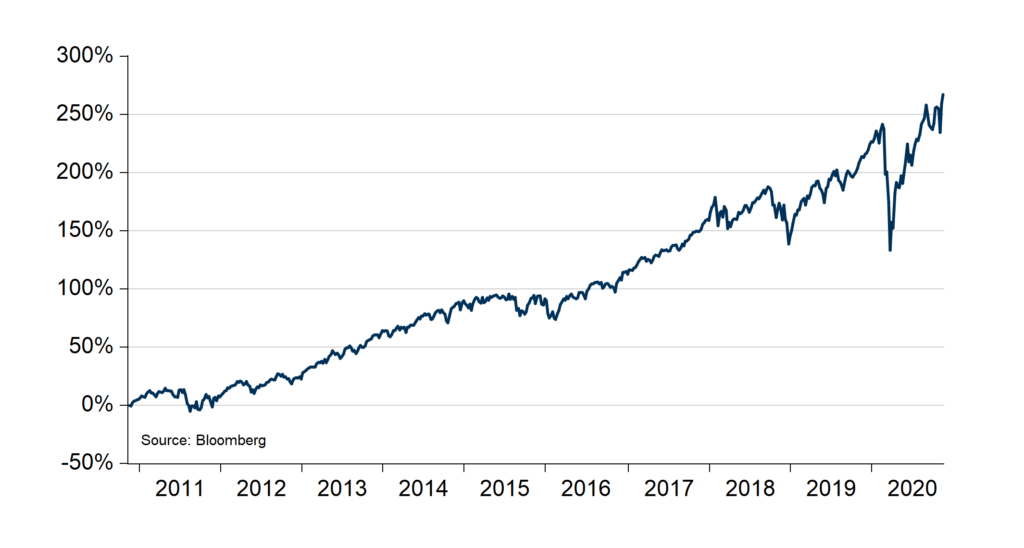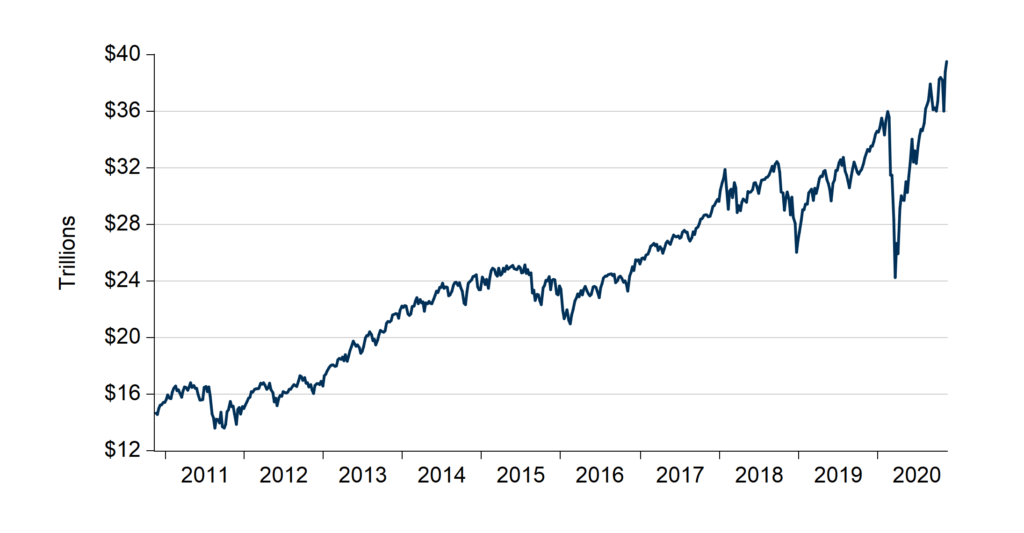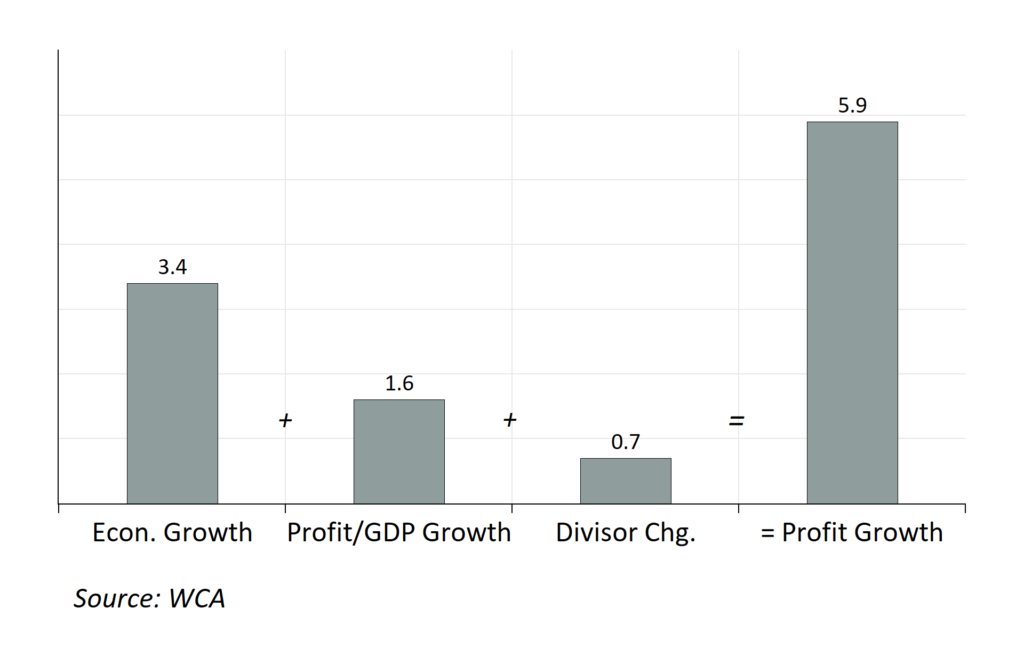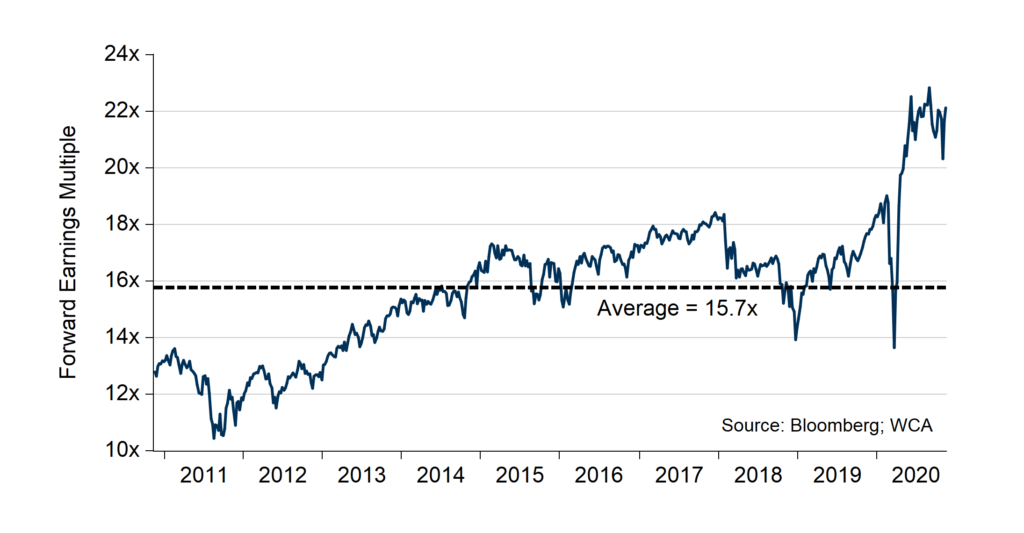A Good Decade
Investment returns are the reward sought by all investors, not small returns or unpredictable returns, but large and guaranteed ones. Unfortunately, those sorts of returns are imaginary. This is not to say that estimation, a more respectable form of imagination, is not in widespread practice. All investors imagine some sort of plausible future of some kind, with some sort of expected reward. These imaginings are behind every dollar invested in the world today.
“By the end of the next decade, quite a way off, there will be a pandemic, and stock investors will achieve record wealth.” These words, if uttered a decade ago, would have sounded crazy. As it turns out, they would have also been prophetic. What’s more, absolutely nobody spoke them, but that prophecy is what happened.
From the third quarter of 2010 to now, the S&P 500, a measure of large U.S. public companies’ performance, returned a whopping 14.3% on an annualized basis or 270% cumulatively (Chart A, below). U.S. stocks gained $27 trillion in value over the period, rising to $40 trillion today from $13 trillion a decade ago (Chart B, below). Corporations also paid over $8.5 trillion in dividends. How did this happen, especially in the wake of the most significant financial crisis since the Great Depression?
Chart A
S&P 500 Total Return (November 2010 – November 2020)

Chart B
United States Equity Market Capitalization (November 2010 – November 2020)

Simple Arithmetic
We believe that returns are rooted in fundamentals that can be measured. Looking back over the past decade’s performance, we see that the 14.3% return can be traced to three sources:
- 5.9% annual growth in profits;
- 5.9% annual rise in valuations;
- 1.9% annual return from dividends.
Arithmetic proof: We get to 14.3% by multiplying 1.059 * 1.059 * 1.019 and subtracting 1 from the product of those three numbers. Voila! A superior and surprising return!
Deeper Dive
The bulk of the return was generated “fundamentally” through the operations of businesses. The 5.9% profit growth and 1.9% dividend flowed from the operations of individual companies. The remaining 5.9% is tied to “market” or “macro” factors outside the business’s control. Interest rates and market psychology, for example, can influence whether the market carries a high or low valuation. Most of the return came from “fundamental” rather than “market” factors, though.
Profit Growth
(Primary Importance)
The most important fundamental factor is growth. The 5.9% profit growth came about because of three primary forces (Chart C, below).
- First, the U.S. economy grew by about 3.4% per year, with about 1.7% coming from “real” growth (higher quantity of sales) and 1.7% coming from price increases (inflation).
- Second, business claimed a larger share of the economic pie. In 2010, S&P 500 profits were near $850 billion (5.7% of the economy, measured by gross domestic product, or GDP). Today, S&P 500 profits are over $1.4 trillion, or 6.7% of GDP. This translates into a 1.6% annual growth rate in large public company’s share of economic output and income over the last decade.
- Third, and a somewhat technical point, declining shares outstanding has increased the “per share” figures for the S&P 500. The “divisor,” used to adjust billions or trillions of dollar values to index values, is lower today than ten years ago. Most of the reason for the decline relates to share buybacks. The divisor decrease added about 0.7% per year to “per share” profit growth on top of total profit growth.
Chart C
S&P 500 Contributors (%) to Profit Growth (2010-2020)

So the wellspring of return is growth in profits. Apart from rising valuations over the decade, it was by far the largest contributor to return. Even dividend yield paled in comparison, adding only another 1.9% to the return total. Growth, after all, is the main reason why most investors buy stocks at all.
Valuation
(Secondary Importance)
None of the underpinnings of “fundamental” returns above seem all that unreasonable. Some growth in the economy, a little inflation, dividends, and buybacks seem like reasonable bets. Continuation of a long-running, secular trend toward rising corporate profitability might be an area of controversy. Still, there is little evidence of the trend reversing at the moment. Fundamental drivers of return have been, and continue to appear, well-grounded.
The market multiple, or valuation, paid for a dollar of earnings is less certain (Chart D, below). Today, the S&P 500 trades at 22.2x forward-looking analyst estimates of operating earnings ($163). Ten years ago, this multiple stood at 12.4x. The fall in long-term U.S. Treasury bond rates to 0.9% from 3.5-3.75% contributed to the rise in stock multiples. As Treasury yields fall, investors are more likely to find stock investments more attractive, contributing to an increase in equity valuations.
The rise in market valuations enjoyed for the past decade are not likely to repeat, in our view. If such a tailwind were to repeat, the forward price-earnings multiple for the S&P 500 would need to reach 40x by 2030, a significant stretch. More likely, we envision the multiple to revert to a historically average level near 15x, creating a drag on returns.
Chart D
S&P 500 Valuation
Price / Forward 12-Month Analyst Earnings Estimate

Future Reward?
The last decade has been a rewarding one, although it began in the shadow of the great financial crisis and is ending amid a pandemic. Still, record levels of wealth are being created.
There are imperfect parallels in history. The early-1950s and mid-1980s were both times of prosperity. Stock indices had been on a vigorous upward climb in the prior decade, and returns in the rear-view mirror were ample. Still, stocks continued to generate healthy but lower returns for several more years. From 1950 to 1959, the market returned about 9% a year, on average, and from 1985 to 2000, the stock market returned about 7% annually. There is no reason to believe that a similar result can’t repeat.
In both cases, a strong and growing economy contributed most to the market’s success. The past decade’s large gains occurred as the globe climbed out of the great financial crisis of 2007-2008. Few in 2010 imagined or predicted (we included) everything that actually came to pass. As the world stands at another turning point and seeks a way out of the pandemic, a plausible case for future reward for stock investing still exists.
Investing is not about knowing everything about the future. It is about having a philosophy and discipline that gets one through all the things that can’t possibly be imagined in advance.
Disclosures:
The Washington Crossing Advisors’ High Quality Index and Low Quality Index are objective, quantitative measures designed to identify quality in the top 1,000 U.S. companies. Ranked by fundamental factors, WCA grades companies from “A” (top quintile) to “F” (bottom quintile). Factors include debt relative to equity, asset profitability, and consistency in performance. Companies with lower debt, higher profitability, and greater consistency earn higher grades. These indices are reconstituted annually and rebalanced daily. For informational purposes only, and WCA Quality Grade indices do not reflect the performance of any WCA investment strategy.
Standard & Poor’s 500 Index (S&P 500) is a capitalization-weighted index that is generally considered representative of the U.S. large capitalization market.
The S&P 500 Equal Weight Index is the equal-weight version of the widely regarded Standard & Poor’s 500 Index, which is generally considered representative of the U.S. large capitalization market. The index has the same constituents as the capitalization-weighted S&P 500, but each company in the index is allocated a fixed weight of 0.20% at each quarterly rebalancing.
The information contained herein has been prepared from sources believed to be reliable but is not guaranteed by us and is not a complete summary or statement of all available data, nor is it considered an offer to buy or sell any securities referred to herein. Opinions expressed are subject to change without notice and do not take into account the particular investment objectives, financial situation, or needs of individual investors. There is no guarantee that the figures or opinions forecast in this report will be realized or achieved. Employees of Stifel, Nicolaus & Company, Incorporated or its affiliates may, at times, release written or oral commentary, technical analysis, or trading strategies that differ from the opinions expressed within. Past performance is no guarantee of future results. Indices are unmanaged, and you cannot invest directly in an index.
Asset allocation and diversification do not ensure a profit and may not protect against loss. There are special considerations associated with international investing, including the risk of currency fluctuations and political and economic events. Changes in market conditions or a company’s financial condition may impact a company’s ability to continue to pay dividends, and companies may also choose to discontinue dividend payments. Investing in emerging markets may involve greater risk and volatility than investing in more developed countries. Due to their narrow focus, sector-based investments typically exhibit greater volatility. Small-company stocks are typically more volatile and carry additional risks since smaller companies generally are not as well established as larger companies. Property values can fall due to environmental, economic, or other reasons, and changes in interest rates can negatively impact the performance of real estate companies. When investing in bonds, it is important to note that as interest rates rise, bond prices will fall. High-yield bonds have greater credit risk than higher-quality bonds. Bond laddering does not assure a profit or protect against loss in a declining market. The risk of loss in trading commodities and futures can be substantial. You should therefore carefully consider whether such trading is suitable for you in light of your financial condition. The high degree of leverage that is often obtainable in commodity trading can work against you as well as for you. The use of leverage can lead to large losses as well as gains. Changes in market conditions or a company’s financial condition may impact a company’s ability to continue to pay dividends, and companies may also choose to discontinue dividend payments.
All investments involve risk, including loss of principal, and there is no guarantee that investment objectives will be met. It is important to review your investment objectives, risk tolerance, and liquidity needs before choosing an investment style or manager. Equity investments are subject generally to market, market sector, market liquidity, issuer, and investment style risks, among other factors to varying degrees. Fixed Income investments are subject to market, market liquidity, issuer, investment style, interest rate, credit quality, and call risks, among other factors to varying degrees.
This commentary often expresses opinions about the direction of market, investment sector, and other trends. The opinions should not be considered predictions of future results. The information contained in this report is based on sources believed to be reliable, but is not guaranteed and not necessarily complete.
The securities discussed in this material were selected due to recent changes in the strategies. This selection criterion is not based on any measurement of performance of the underlying security.
Washington Crossing Advisors, LLC is a wholly-owned subsidiary and affiliated SEC Registered Investment Adviser of Stifel Financial Corp (NYSE: SF). Registration with the SEC implies no level of sophistication in investment management.



